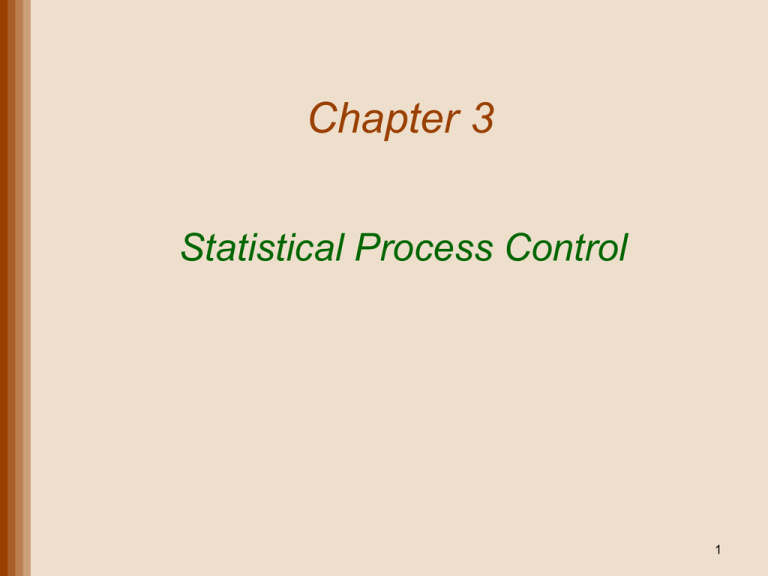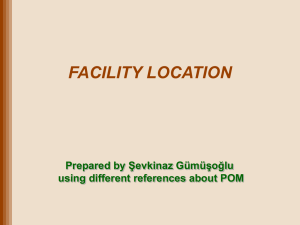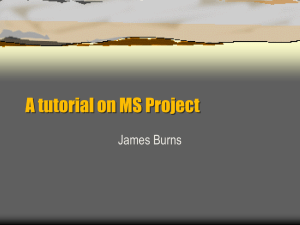
Chapter 3
Statistical Process Control
1
Lecture Outline
•
•
•
•
•
•
•
Basics of Statistical Process Control
Control Charts
Control Charts for Attributes
Control Charts for Variables
Control Chart Patterns
SPC with Excel and OM Tools
Process Capability
Copyright 2011 John Wiley & Sons, Inc.
3-2
Statistical Process Control (SPC)
• Statistical Process Control
• monitoring production process
to detect and prevent poor
quality
UCL
• Sample
• subset of items produced to
use for inspection
LCL
• Control Charts
• process is within statistical
control limits
Copyright 2011 John Wiley & Sons, Inc.
3-3
Process Variability
• Random
• inherent in a process
• depends on equipment
and machinery,
engineering, operator,
and system of
measurement
• natural occurrences
Copyright 2011 John Wiley & Sons, Inc.
• Non-Random
• special causes
• identifiable and
correctable
• include equipment out of
adjustment, defective
materials, changes in
parts or materials, broken
machinery or equipment,
operator fatigue or poor
work methods, or errors
due to lack of training
3-4
SPC in Quality Management
• SPC uses
• Is the process in control?
• Identify problems in order to make
improvements
• Contribute to the TQM goal of continuous
improvement
Copyright 2011 John Wiley & Sons, Inc.
3-5
Quality Measures:
Attributes and Variables
• Attribute
• A characteristic which is evaluated with a
discrete response
• good/bad; yes/no; correct/incorrect
• Variable measure
• A characteristic that is continuous and can be
measured
• Weight, length, voltage, volume
Copyright 2011 John Wiley & Sons, Inc.
3-6
SPC Applied to Services
• Nature of defects is different in services
• Service defect is a failure to meet customer
requirements
• Monitor time and customer satisfaction
Copyright 2011 John Wiley & Sons, Inc.
3-7
SPC Applied to Services
• Hospitals
• timeliness & quickness of care, staff responses to requests,
accuracy of lab tests, cleanliness, courtesy, accuracy of
paperwork, speed of admittance & checkouts
• Grocery stores
• waiting time to check out, frequency of out-of-stock items, quality
of food items, cleanliness, customer complaints, checkout
register errors
• Airlines
• flight delays, lost luggage & luggage handling, waiting time at
ticket counters & check-in, agent & flight attendant courtesy,
accurate flight information, cabin cleanliness & maintenance
Copyright 2011 John Wiley & Sons, Inc.
3-8
SPC Applied to Services
• Fast-food restaurants
• waiting time for service, customer complaints, cleanliness, food
quality, order accuracy, employee courtesy
• Catalogue-order companies
• order accuracy, operator knowledge & courtesy, packaging,
delivery time, phone order waiting time
• Insurance companies
• billing accuracy, timeliness of claims processing, agent
availability & response time
Copyright 2011 John Wiley & Sons, Inc.
3-9
Where to Use Control Charts
• Process
• Has a tendency to go out of control
• Is particularly harmful and costly if it goes out of control
• Examples
• At beginning of process because of waste to begin
production process with bad supplies
• Before a costly or irreversible point, after which product is
difficult to rework or correct
• Before and after assembly or painting operations that
might cover defects
• Before the outgoing final product or service is delivered
Copyright 2011 John Wiley & Sons, Inc.
3-10
Control Charts
• A graph that monitors process quality
• Control limits
• upper and lower bands of a control chart
• Attributes chart
• p-chart
• c-chart
• Variables chart
• mean (x bar – chart)
• range (R-chart)
Copyright 2011 John Wiley & Sons, Inc.
3-11
Process Control Chart
Out of control
Upper
control
limit
Process
average
Lower
control
limit
1
2
3
4
5
6
7
8
9
10
Sample number
Copyright 2011 John Wiley & Sons, Inc.
3-12
Normal Distribution
• Probabilities for Z= 2.00 and Z = 3.00
95%
99.74%
-3
-2
Copyright 2011 John Wiley & Sons, Inc.
-1
=0
1
2
3
3-13
A Process Is in Control If …
1. … no sample points outside limits
2. … most points near process average
3. … about equal number of points above
and below centerline
4. … points appear randomly distributed
Copyright 2011 John Wiley & Sons, Inc.
3-14
Control Charts for Attributes
• p-chart
• uses portion defective in a sample
• c-chart
• uses number of defects (non-conformities) in a
sample
Copyright 2011 John Wiley & Sons, Inc.
3-15
p-Chart
UCL = p + zp
LCL = p - zp
z = number of standard deviations from process average
p = sample proportion defective; estimates process mean
p = standard deviation of sample proportion
p =
Copyright 2011 John Wiley & Sons, Inc.
p(1 - p)
n
3-16
Construction of p-Chart
SAMPLE #
1
2
3
:
:
20
NUMBER OF
DEFECTIVES
PROPORTION
DEFECTIVE
6
0
4
:
:
18
200
.06
.00
.04
:
:
.18
20 samples of 100 pairs of jeans
Copyright 2011 John Wiley & Sons, Inc.
3-17
Construction of p-Chart
p=
total defectives
total sample observations
UCL = p + z
= 200 / 20(100) = 0.10
p(1 - p)
= 0.10 + 3
n
0.10(1 - 0.10)
100
UCL = 0.190
LCL = p - z
p(1 - p)
= 0.10 - 3
n
0.10(1 - 0.10)
100
LCL = 0.010
Copyright 2011 John Wiley & Sons, Inc.
3-18
Construction of p-Chart
0.20
UCL = 0.190
0.18
Proportion defective
0.16
0.14
0.12
0.10
p = 0.10
0.08
0.06
0.04
0.02
LCL = 0.010
2
Copyright 2011 John Wiley & Sons, Inc.
4
6
8
10
12
Sample number
14
16
18
20
3-19
p-Chart in Excel
Click on “Insert” then “Charts”
to construct control chart
I4 + 3*SQRT(I4*(1-I4)/100)
I4 - 3*SQRT(I4*(1-I4)/100)
Column values copied
from I5 and I6
Copyright 2011 John Wiley & Sons, Inc.
3-20
c-Chart
UCL = c + zc
LCL = c - zc
c =
c
where
c = number of defects per sample
Copyright 2011 John Wiley & Sons, Inc.
3-21
c-Chart
Number of defects in 15 sample rooms
SAMPLE
NUMBER
OF
DEFECTS
1
2
3
12
8
16
:
:
:
:
15
15
190
Copyright 2011 John Wiley & Sons, Inc.
190
c=
= 12.67
15
UCL = c + zc
= 12.67 + 3
= 23.35
12.67
LCL = c - zc
= 12.67 - 3
= 1.99
12.67
3-22
c-Chart
24
UCL = 23.35
Number of defects
21
18
c = 12.67
15
12
9
6
LCL = 1.99
3
2
4
6
8
10
12
14
16
Sample number
Copyright 2011 John Wiley & Sons, Inc.
3-23
Control Charts for Variables
Range chart ( R-Chart )
Plot sample range (variability)
Mean chart ( x -Chart )
Plot sample averages
Copyright 2011 John Wiley & Sons, Inc.
3-24
x-bar Chart: Known
UCL = =
x + z xLCL = =
x - z -x
Where
- + x- + ... + xx
=
2
k
X= 1
k
= process standard deviation
x = standard deviation of sample means =/ n
k = number of samples (subgroups)
n = sample size (number of observations)
Copyright 2011 John Wiley & Sons, Inc.
3-25
x-bar Chart Example: Known
Observations(Slip-Ring Diameter, cm) n
Sample k
1
2
3
4
5
-x
We know σ = .08
Copyright 2011 John Wiley & Sons, Inc.
3-26
x-bar Chart Example: Known
= 50.09
X = _____ = 5.01
10
=
UCL = x + z -x
= 5.01 + 3(.08 / 10)
= 5.09
Copyright 2011 John Wiley & Sons, Inc.
LCL = =
x - z -x
= 5.01 - 3(.08 / 10)
= 4.93
3-27
x-bar Chart Example: Unknown
_
UCL = =x + A2R
_
LCL = x= - A2R
where
=
x = average of the sample means
_
R = average range value
Copyright 2011 John Wiley & Sons, Inc.
3-28
Control
Chart
Factors
Sample
Size
n
2
3
4
5
6
7
8
9
10
11
12
13
14
15
16
17
18
19
20
21
22
23
24
25
Copyright 2011 John Wiley & Sons, Inc.
Factor for X-chart
A2
1.880
1.023
0.729
0.577
0.483
0.419
0.373
0.337
0.308
0.285
0.266
0.249
0.235
0.223
0.212
0.203
0.194
0.187
0.180
0.173
0.167
0.162
0.157
0.153
Factors for R-chart
D3
0.000
0.000
0.000
0.000
0.000
0.076
0.136
0.184
0.223
0.256
0.283
0.307
0.328
0.347
0.363
0.378
0.391
0.404
0.415
0.425
0.435
0.443
0.452
0.459
D4
3.267
2.575
2.282
2.114
2.004
1.924
1.864
1.816
1.777
1.744
1.717
1.693
1.672
1.653
1.637
1.622
1.609
1.596
1.585
1.575
1.565
1.557
1.548
1.541
3-29
x-bar Chart Example: Unknown
OBSERVATIONS (SLIP- RING DIAMETER, CM)
SAMPLE k
1
2
3
4
5
x
R
1
2
3
4
5
6
7
8
9
10
5.02
5.01
4.99
5.03
4.95
4.97
5.05
5.09
5.14
5.01
5.01
5.03
5.00
4.91
4.92
5.06
5.01
5.10
5.10
4.98
4.94
5.07
4.93
5.01
5.03
5.06
5.10
5.00
4.99
5.08
4.99
4.95
4.92
4.98
5.05
4.96
4.96
4.99
5.08
5.07
4.96
4.96
4.99
4.89
5.01
5.03
4.99
5.08
5.09
4.99
4.98
5.00
4.97
4.96
4.99
5.01
5.02
5.05
5.08
5.03
0.08
0.12
0.08
0.14
0.13
0.10
0.14
0.11
0.15
0.10
Totals 50.09
1.15
Copyright 2011 John Wiley & Sons, Inc.
3-30
x-bar Chart Example: Unknown
_
R=
∑R
____
=
k
1.15
____
10 = 0.115
x
50.09
_____
=
___
x=
=
= 5.01 cm
10
k
_
=
UCL = x + A2R = 5.01 + (0.58)(0.115) = 5.08
_
=
LCL = x - A2R = 5.01 - (0.58)(0.115) = 4.94
Copyright 2011 John Wiley & Sons, Inc.
3-31
x- bar
Chart
Example
5.10 –
5.08 –
UCL = 5.08
5.06 –
Mean
5.04 –
5.02 –
=
x = 5.01
5.00 –
4.98 –
4.96 –
LCL = 4.94
4.94 –
4.92 –
|
1
Copyright 2011 John Wiley & Sons, Inc.
|
2
|
3
|
|
|
|
4
5
6
7
Sample number
|
8
|
9
|
10
3-32
R- Chart
UCL = D4R
R=
LCL = D3R
R
k
Where
R = range of each sample
k = number of samples (sub groups)
Copyright 2011 John Wiley & Sons, Inc.
3-33
R-Chart Example
OBSERVATIONS (SLIP- RING DIAMETER, CM)
SAMPLE k
1
2
3
4
5
x
R
1
2
3
4
5
6
7
8
9
10
5.02
5.01
4.99
5.03
4.95
4.97
5.05
5.09
5.14
5.01
5.01
5.03
5.00
4.91
4.92
5.06
5.01
5.10
5.10
4.98
4.94
5.07
4.93
5.01
5.03
5.06
5.10
5.00
4.99
5.08
4.99
4.95
4.92
4.98
5.05
4.96
4.96
4.99
5.08
5.07
4.96
4.96
4.99
4.89
5.01
5.03
4.99
5.08
5.09
4.99
4.98
5.00
4.97
4.96
4.99
5.01
5.02
5.05
5.08
5.03
0.08
0.12
0.08
0.14
0.13
0.10
0.14
0.11
0.15
0.10
Totals 50.09
1.15
Copyright 2011 John Wiley & Sons, Inc.
3-34
R-Chart Example
_
UCL = D4R = 2.11(0.115) = 0.243
_
LCL = D3R = 0(0.115) = 0
Retrieve chart factors D3 and D4
Copyright 2011 John Wiley & Sons, Inc.
3-35
R-Chart Example
0.28 –
0.24 –
Range
0.20 –
0.16 –
UCL = 0.243
R = 0.115
0.12 –
0.08 –
0.04 –
0–
LCL = 0
|
|
|
1
2
3
Copyright 2011 John Wiley & Sons, Inc.
|
|
|
|
4
5
6
7
Sample number
|
8
|
9
|
10
3-36
X-bar and R charts – Excel & OM Tools
Copyright 2011 John Wiley & Sons, Inc.
3-37
Using x- bar and R-Charts Together
• Process average and process variability must be
in control
• Samples can have very narrow ranges, but
sample averages might be beyond control limits
• Or, sample averages may be in control, but
ranges might be out of control
• An R-chart might show a distinct downward
trend, suggesting some nonrandom cause is
reducing variation
Copyright 2011 John Wiley & Sons, Inc.
3-38
Control Chart Patterns
• Run
• sequence of sample values that display same
characteristic
• Pattern test
• determines if observations within limits of a control
chart display a nonrandom pattern
Copyright 2011 John Wiley & Sons, Inc.
3-39
Control Chart Patterns
• To identify a pattern look for:
•
•
•
•
8 consecutive points on one side of the center line
8 consecutive points up or down
14 points alternating up or down
2 out of 3 consecutive points in zone A (on one side of
center line)
• 4 out of 5 consecutive points in zone A or B (on one
side of center line)
Copyright 2011 John Wiley & Sons, Inc.
3-40
Control Chart Patterns
UCL
UCL
LCL
LCL
Sample observations
consistently below the
center line
Copyright 2011 John Wiley & Sons, Inc.
Sample observations
consistently above the
center line
3-41
Control Chart Patterns
UCL
UCL
LCL
LCL
Sample observations
consistently increasing
Copyright 2011 John Wiley & Sons, Inc.
Sample observations
consistently decreasing
3-42
Zones for Pattern Tests
=
3 sigma = x + A2R
UCL
Zone A
=
2
2 sigma = x + 3 (A2R)
Zone B
=
1
1 sigma = x + 3 (A2R)
Zone C
Process
average
=
x
Zone C
=
1 sigma = x - 1 (A2R)
3
Zone B
=
2 sigma = x - 2 (A2R)
3
Zone A
=
3 sigma = x - A2R
LCL
|
1
|
2
|
3
|
4
|
5
|
6
|
7
|
8
|
9
|
10
|
11
|
12
|
13
Sample number
Copyright 2011 John Wiley & Sons, Inc.
3-43
Performing a Pattern Test
SAMPLE
1
2
3
4
5
6
7
8
9
10
x
ABOVE/BELOW
UP/DOWN
ZONE
4.98
5.00
4.95
4.96
4.99
5.01
5.02
5.05
5.08
5.03
B
B
B
B
B
—
A
A
A
A
—
U
D
D
U
U
U
U
U
D
B
C
A
A
C
C
C
B
A
B
Copyright 2011 John Wiley & Sons, Inc.
3-44
Sample Size Determination
• Attribute charts require larger sample sizes
• 50 to 100 parts in a sample
• Variable charts require smaller samples
• 2 to 10 parts in a sample
Copyright 2011 John Wiley & Sons, Inc.
3-45
Process Capability
• Compare natural variability to design variability
• Natural variability
• What we measure with control charts
• Process mean = 8.80 oz, Std dev. = 0.12 oz
• Tolerances
• Design specifications reflecting product
requirements
• Net weight = 9.0 oz 0.5 oz
• Tolerances are 0.5 oz
Copyright 2011 John Wiley & Sons, Inc.
3-46
Process Capability
Design
Specifications
(a) Natural variation
exceeds design
specifications; process is
not capable of meeting
specifications all the
time.
Process
Design
Specifications
(b) Design specifications
and natural variation the
same; process is capable
of meeting specifications
most of the time.
Process
Copyright 2011 John Wiley & Sons, Inc.
3-47
Process Capability
Design
Specifications
(c) Design specifications
greater than natural
variation; process is
capable of always
conforming to
specifications.
Process
Design
Specifications
(d) Specifications greater
than natural variation, but
process off center; capable
but some output will not
meet upper specification.
Process
Copyright 2011 John Wiley & Sons, Inc.
3-48
Process Capability Ratio
Cp =
=
tolerance range
process range
upper spec limit - lower spec limit
6
Copyright 2011 John Wiley & Sons, Inc.
3-49
Computing Cp
Net weight specification = 9.0 oz 0.5 oz
Process mean = 8.80 oz
Process standard deviation = 0.12 oz
upper specification limit lower specification limit
Cp =
6
9.5 - 8.5
=
= 1.39
6(0.12)
Copyright 2011 John Wiley & Sons, Inc.
3-50
Process Capability Index
Cpk = minimum
Copyright 2011 John Wiley & Sons, Inc.
=
x - lower specification limit
3
,
=
upper specification limit - x
3
3-51
Computing Cpk
Net weight specification = 9.0 oz 0.5 oz
Process mean = 8.80 oz
Process standard deviation = 0.12 oz
Cpk = minimum
=
x - lower specification limit
,
3
=
upper specification limit - x
3
= minimum
8.80 - 8.50 9.50 - 8.80
,
= 0.83
3(0.12)
3(0.12)
Copyright 2011 John Wiley & Sons, Inc.
3-52
Process Capability With Excel
=(D6-D7)/(6*D8)
See formula bar
Copyright 2011 John Wiley & Sons, Inc.
3-53
Process Capability With OM Tools
Copyright 2011 John Wiley & Sons, Inc.
3-54
Copyright 2011 John Wiley & Sons, Inc.
All rights reserved. Reproduction or translation of this
work beyond that permitted in section 117 of the 1976
United States Copyright Act without express permission
of the copyright owner is unlawful. Request for further
information should be addressed to the Permission
Department, John Wiley & Sons, Inc. The purchaser
may make back-up copies for his/her own use only and
not for distribution or resale. The Publisher assumes no
responsibility for errors, omissions, or damages caused
by the use of these programs or from the use of the
information herein.
Copyright 2011 John Wiley & Sons, Inc.
3-55









